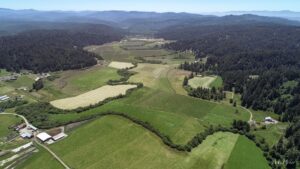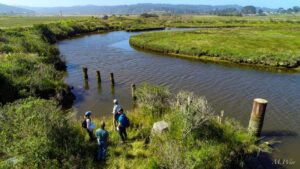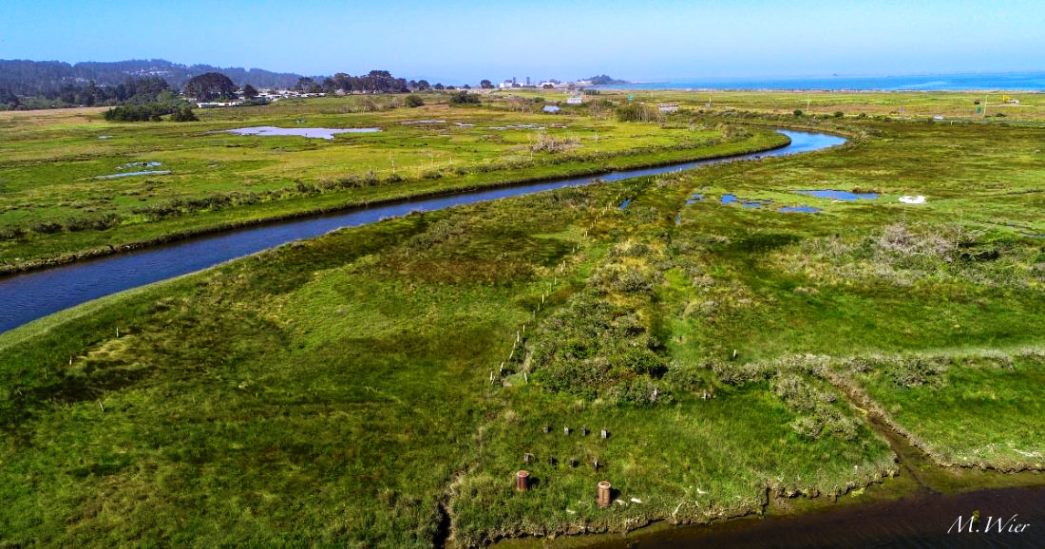Land use changes in watersheds often lead to ecological degradation, but with degradation comes great opportunity for restoration.
With the release of their new Elk River Recovery Plan, California Trout and its partners are actively pursuing restoration opportunities in the Elk River watershed.
A Transformed Watershed
 The Elk River is the largest tributary to Humboldt Bay, joining the bay just south of the city of Eureka, California.
The Elk River is the largest tributary to Humboldt Bay, joining the bay just south of the city of Eureka, California.
Located in the heart of the ancestral lands of the Wiyot Tribe, the Elk River watershed has been extensively altered over the past 170 years, when European settlers first arrived in the region.
Once a complex tapestry of forest, wetland, and aquatic ecosystems, the watershed has since been transformed into a patchwork of working landscapes providing timber resources, agricultural and grazing lands, and homes to many residents.
Transformation into a working landscape has led to economic and agricultural productivity, but it has also introduced problems within the community. Water quality and habitat in the Elk River is degraded, water supply to residents is disrupted, and residential communities often experience flooding.
To address these problems and to support improvements within the community, California Trout, the North Coast Regional Water Board, and several project partners joined together to form the Elk River Watershed Stewardship Program.
Since 2018, the Stewardship Program has actively engaged with watershed residents and stakeholders to solicit input and relay information on potential recovery actions. The Elk River Recovery Plan is the culmination of the past few years of work to identify and prioritize feasible restoration actions and develop a plan to carry out these actions.
The Elk River Recovery Plan
 The goal of the Recovery Plan is not to return the Elk to its historic pristine condition or to introduce major land use changes to the watershed; its current land use and land ownership make that outcome unrealistic.
The goal of the Recovery Plan is not to return the Elk to its historic pristine condition or to introduce major land use changes to the watershed; its current land use and land ownership make that outcome unrealistic.
However, the plan does intend to set the river on a trajectory of recovery and to restore the capacity for the stream ecosystem to eventually maintain itself, while also making the river more resilient to future conditions including climate change, sea level rise, and further land uses. In order to accomplish this, the plan provides a concise blueprint of strategies and resources necessary to achieved desired conservation outcomes and goals.
Support and involvement from the community has always been a key priority of the Stewardship Program and the resulting Recovery Plan. The plan develops and outlines steps to implement a suite of voluntary actions that are supported by landowners, regulatory agencies, and other stakeholder.
These actions will address three main restorative outcomes:
- Remediate the impacts of legacy fine sediment deposited in the Elk River channel;
- Reduce the risk and occurrence of nuisance flooding in the Elk River; and
- Promote aquatic and riparian habitat remediation and the recovery of threatened salmon and steelhead populations.
Anadromous Fish Habitat Threatened
Historically, anadromous salmonids were abundant in the Elk River, but today much of that critical habitat is threatened for four key species: coho salmon, Chinook salmon, steelhead, and coastal cutthroat trout. Chinook, coho, and steelhead are currently listed as threatened under the Federal Endangered Species Act.
The population of Southern Oregon/Northern California Coast coho salmon present in the Elk River are part of the larger Humboldt Bay Tributaries population that is noted by the National Marine Fisheries Service to be the highest priority for recovery, indicating the importance of restoring habitat in the Elk for the survival of the species as a whole.
Because the Elk River once supported these fish populations, we know it could do so again given the opportunity for restoration.
CalTrout believes that the Recovery Plan will improve not only the health of the watershed but also the lives of the people who live, work, and recreate there. Its leaders say they we are excited for this future of restoration within the Elk River watershed.
Photos courtesy of California Trout.

